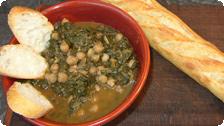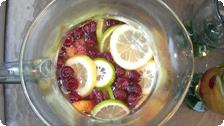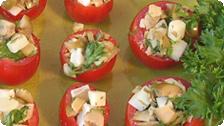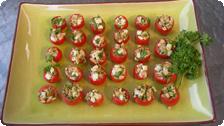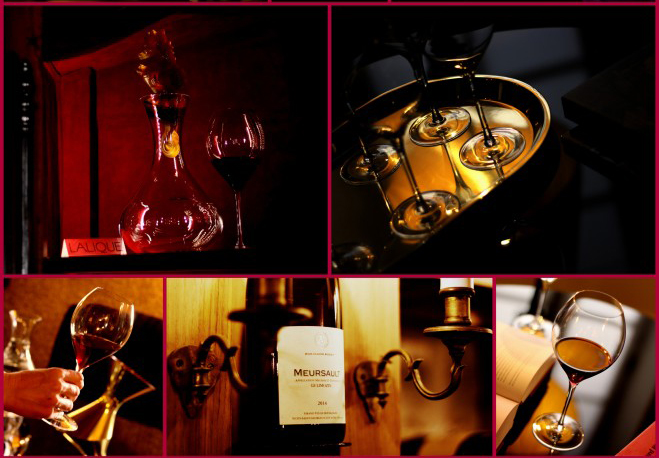Culture: Seville, Spain: Going Tapas (Recipes included)
by Suzanne Dunning
It was a sizzling summer afternoon in Seville, Spain. The temperature was well over a hundred, and my backpack felt like it had melted my shirt and adhered to my skin. My feet had turned a dusty gray from hours of walking on dusty, cobbled roads.
Wafts of cool air passing through the arched whitewashed doorways of courtyard patios provided brief respite from the heat. I could hear the splashing of clear, cool water dripping from Moorish-style fountains into pools lined with colored tiles within the courtyards, lush with banana trees and palms.
Passing by a typical Sevillan bar, I was engulfed by the smell of frying garlic and coriander leaves. I peered through the open doorway. Huge legs of jamon serrano (cured ham) hung from the rafters, and barrels of wine were stacked off to one side. The tables were empty. A woman with intense black eyes and a crisp white apron informed me that the restaurant would be open in an hour.
Returning later that night, my friends and I encountered crowds spilling out onto the street. We squeezed our way to the bar, which was covered with plates of tapas. The noise of laughter and chatter was deafening, confirming, in my mind, Spain’s reputation as the second loudest country in the world. We ordered glasses of wine and began feasting on the grilled portabella mushrooms, marinated olives, delicate slices of Spanish omelet, and squid soaked in saffron and wine. When our glasses were empty we moved down the street to the next bodega, and then onto the third.
Tapas, traditionally served in bodegas, or wine bars, range from octopus boiled with paprika to almond and garlic soup with grapes. The popular small plates originated in Seville (today the tapas capital of the world) when little dishes were placed on top of wine glasses to keep fruit flies out. Over time, cooks began putting appetizers on the plates to please the customers—and a new tradition was born!
Tapas are served in nearly every bar in Seville and throughout the rest of Spain. Yet unlike other Spanish cities, where tapas are merely eaten as an appetizer to a bigger lunch or dinner, in Seville, people actually make a meal out of them, moving from bar to bar until they are full.
Returning to the States after two months on the Iberian Penninsula, I went through withdrawal—from the wine, the culture, the smells, and especially the tastes of Spain. To console myself, I began experimenting with my own recipes, writing my friends in Spain for their favorites and looking through cookbooks.
Tapas are typically served with a dry sherry, but I prefer sangria. The recipe for white sangria that I have included here goes nicely with seafood.
¡Disfruta!
* * * *
Recipes
Cherry Tomatoes Stuffed with Manchego Cheese
and Olive Tapenade
1/2 cup green Spanish olives, finely chopped
1 tablespoon capers, finely chopped
2 tablespoons extra-virgin olive oil
1/2 teaspoon lemon zest
1/3 cup Manchego cheese, chopped
3 tablespoons fresh parsley, minced
2 pints cherry tomatoes
fresh ground pepper
Mix the olives, capers, olive oil, lemon zest, Manchego cheese, and parsley together in a small bowl.
Cut a small sliver off the bottoms of each cherry tomato to keep them from rolling. Then slice off the tops and use a small spoon (a melon baller works well) to scoop out seeds. Fill the tomatoes with the olive mixture and then grind fresh black pepper over the top.
Garlic Prawns Wrapped in Proscuitto
24 large prawns
24 thin slices of proscuitto
5 cloves garlic, minced
4 tablespoons olive oil
3/4 teaspoon paprika, or to taste.
sea salt to taste
1/3 cup chopped fresh parsley
Peel the shrimp, leaving the tails on. Season with salt and pepper, then tightly wrap each shrimp with the proscuitto. In a heavy frying pan, (preferably cast iron) or terracotta tapas dish, over a medium flame, heat the olive oil, garlic, paprika until the oil is hot. Add the wrapped prawns and cook for 5–6 minutes, turning half over
half way. Garnish with the chopped parsley. Serve immediately.
White Sangria (makes 8 servings)
2 bottles white Rioja Spanish Wine (or other dry white wine), chilled.
1/2 cup white grape juice
1/2 cup limoncello liqueur
1/4 juice of one lemon
1/4 cup white sugar
2 ripe peaches cut into chunks
1 lime sliced into wheels
1 lemon sliced into wheels
1 pint raspberries
fresh mint leaves
soda water
In a small sauce pan, heat the sugar over low heat with the grape juice until sugar dissolves.
Combine all the ingredients (omitting the soda water, mint and raspberries) in a glass pitcher. Chill for several hours. When ready to serve, add mint leaves and raspberries and a splash of soda water to each glass.
Garbanzo Beans and Spinach
5 tablespoons extra-virgin olive oil
1 large onion finely chopped
4 cloves of garlic, minced
1 large tomato, chopped
2 teaspoons ground cumin
1 teaspoon paprika
sea salt and pepper to taste
2 10-ounce packages of frozen spinach or 2 large bunches of washed, fresh
spinach
2 cups cooked garbanzo beans, rinsed and drained
1 baguette, sliced
Heat the olive oil in a heavy pan over medium heat. Sautee the onion and
garlic for several minutes. Add the tomato, cumin, and paprika. Sautee for
several more minutes.
Chop the spinach coarsely and add it to the pan, along with the garbanzo
beans. (If using frozen spinach, thaw first.) If the spinach is dry add a
few tablespoons of water. Reduce the heat and cover with a lid. Cook,
stirring frequently, until the spinach is cooked and the garbanzo beans
are soft. Add sea salt and pepper to taste.
Serve with hot slices of baguette pan-fried in olive oil.
Discover more from Tango Diva
Subscribe to get the latest posts sent to your email.

